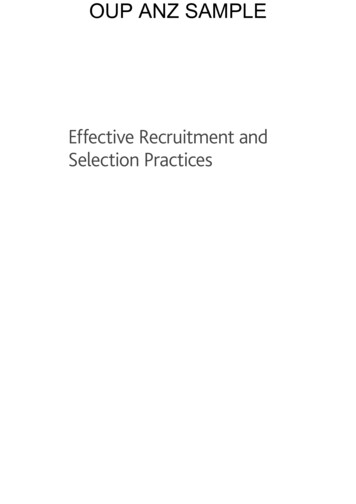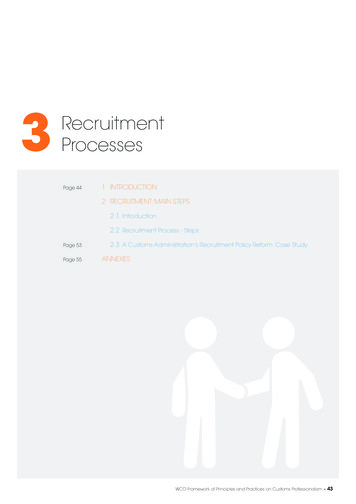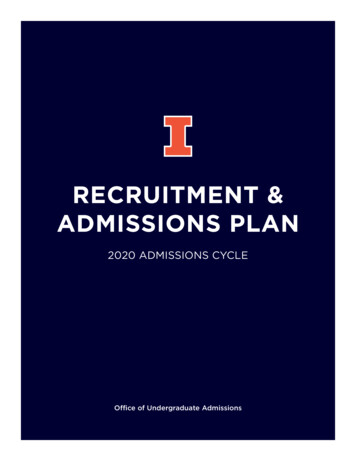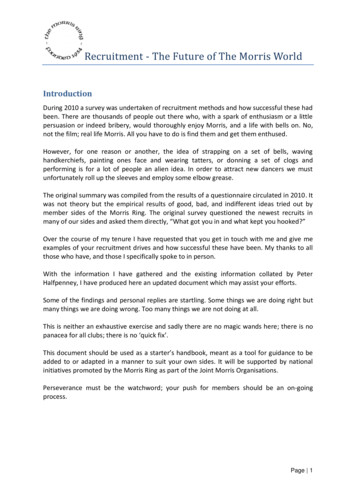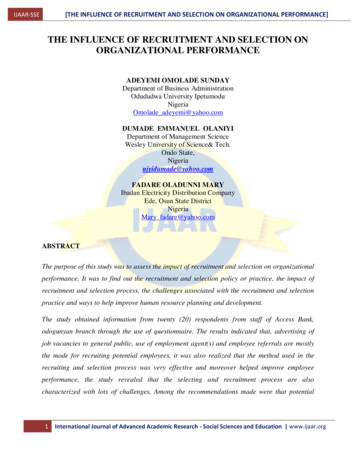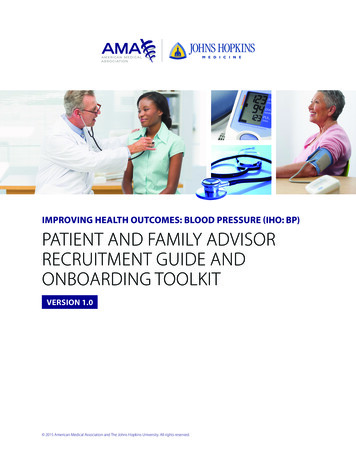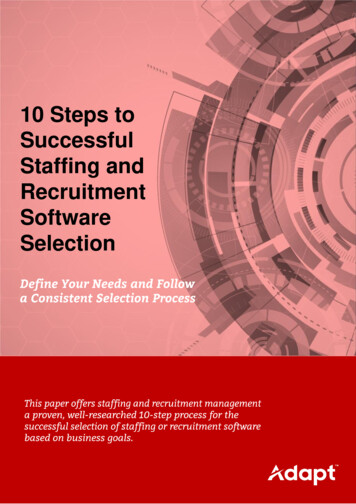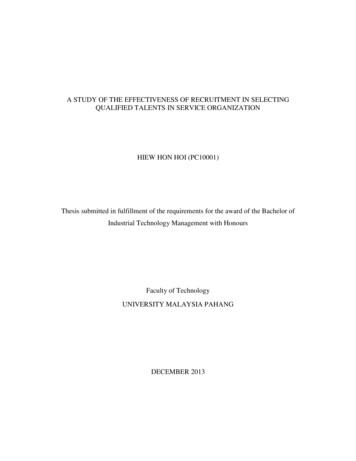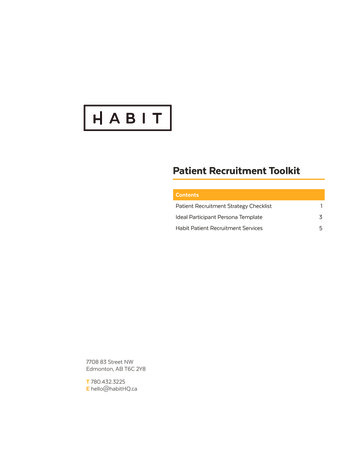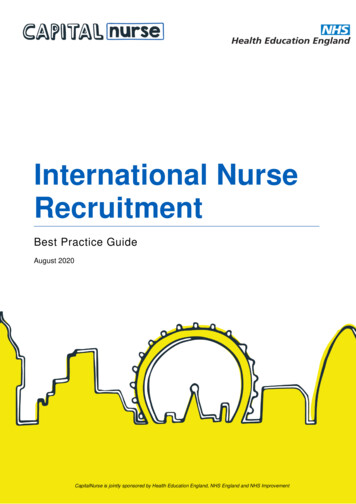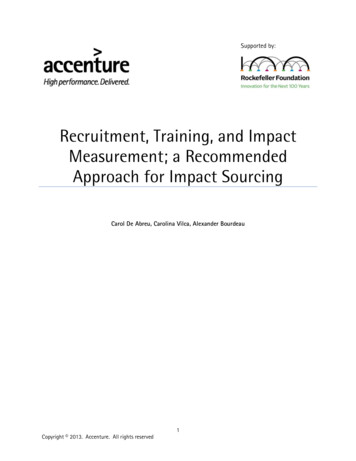
Transcription
Supported by:Recruitment, Training, and ImpactMeasurement; a RecommendedApproach for Impact SourcingCarol De Abreu, Carolina Vilca, Alexander Bourdeau1Copyright 2013. Accenture. All rights reserved
ContentsContents . 2Definitions . 5Introduction. 7Approach . 8Framework . 10Talent Life Cycle . 10Maturity Model. 10How to Use the Maturity Assessment. 11Recruitment . 13Findings . 13Key Recommendations for ISSPs. 15Key Recommendations for Traditional Outsourcing Providers . 16Recommended Recruitment Approach . 17Recruitment Process . 17Recruitment Roles and Responsibilities . 26Recruitment Technology. 27Recruitment Maturity Levels . 28Recruitment Metrics . 31Training . 32Findings . 32Key Recommendations for ISSPs. 34Key Recommendations for Traditional Outsourcing Providers . 35Training Approach . 36Training Process . 37Training Maturity Model . 39Training Needs Assessment . 40Training Curriculum Structure . 41Learning Management System . 47Training Evaluation . 50Impact Measurement . 512Copyright 2013. Accenture. All rights reserved
Background . 51What is Impact Measurement? . 51Why Measure Impact? . 51Considerations for Traditional Outsourcing Organizations . 52Findings . 53Findings: Desk-based Research. 54Findings: Interview and Survey Research. 55Key Recommendations for ISSPs. 58Key Recommendations for Traditional Outsourcing Providers . 58Recommended Approach . 59Process . 59Logical Framework . 60Indicators and Balanced Scorecard . 62Maturity Model . 65Summary. 66Resources. 67Conclusion . 68Table of Figures . 69List of Tables . 70Acknowledgements. 71Appendix A – Interview and Survey Data . 72Appendix B – Maturity Assessment Approach . 76Maturity Assessment Approach – Diagnose Phase . 76Maturity Assessment Approach – Develop Phase. 77Maturity Assessment Approach – Deploy Phase . 78Appendix C – Recruitment Process Flows . 80Appendix D – Competency Model Sample . 84Appendix E – Recruitment Interview Questions . 85Appendix F – Recruitment Interview Guide Template. 86Appendix G – Curriculum. 86Appendix H – Learning Level 1 Satisfaction Survey . 86Appendix I – Learning Path Example . 87Appendix J – Maturity Assessment . 883Copyright 2013. Accenture. All rights reserved
Recruitment . 88Training . 92Impact Measurement . 96Appendix K –Logical Framework, Indicator Catalog, and Balanced Scorecard Examples . 974Copyright 2013. Accenture. All rights reserved
Definitions AO: Application Outsourcing. Technical outsourcing that may include the management, development,testing or upgrade of packaged or customized software (e.g., a financial, human resources, sales,customer relationship management or mobile application) by a third party.BPO: Business Process Outsourcing. Contracting out of specific business processes or operations to athird party -- e.g., wage processing. BPO does not offer technical support; it only takes responsibilityfor a business function, or functions.Client: Organizations that purchase outsourcing services and are potential candidates for buyingImpact Sourcing.Competency: A required skill or knowledge for an individual to perform a specific job.Corporate Social Responsibility (CSR): Corporations encouraging positive impact on environment,employees, and society through its business operationsDisadvantaged individuals: People who are at a unique disadvantage and lack access to traditionalemployment. This can include those living in rural areas of developing countries or in slums, thosewithout access to secondary or tertiary education, or educated individuals in areas of highunemployment.Employees: Local disadvantaged populations that are employed to undertake outsourcing activities.Employee Value Proposition: The rewards and benefits that are received by employees in return fortheir performance in an organization.Impact Sourcing: Outsourcing that benefits disadvantaged individuals in low employment areas. Itlooks beyond the common source of supply for traditional outsourcing to provide higher-incomeemployment and access to new income opportunities to individuals that might not otherwise beemployed in this sector.Impact Measurement: Assessing the long term social and economic development impacts ofoperations and/or philanthropyIO: Infrastructure Outsourcing. Technical outsourcing of the management, development and/orupgrade of information technology infrastructure for running technical services (e.g., email) to a thirdparty.ISSP: Impact Sourcing Service Provider. An organization set up with the explicit intent to undertakeoutsourcing work that is classified as Impact Sourcing.Outsourcing: References all forms of outsourcing, including Application Outsourcing, InfrastructureOutsourcing, and Business Process Outsourcing.Outsourcing center: A physical facility or center where outsourcing tasks are completed. Such acenter may be owned by the ISSP or a Traditional Outsourcer.Replicable: A business model that can become a blueprint for other organizations/entities that areinterested in setting up similar operations.Scalable: An operation that has the characteristics and the capabilities to grow beyond 250 full timeemployees.Shared Value: Concept that business decisions and social policies must benefit each other because ofthe mutual dependence of corporations and society.Sourcing: The identification of job candidates through recruiting techniques.Sustainable: An organization that can continue to operate independently without “donor” support.This organization can be for-profit or not-for-profit. The organization could receive governmentsupport as long as that support is available to all organizations within that community (e.g., a taxbreak for conducting business in the community).5Copyright 2013. Accenture. All rights reserved
Traditional Outsourcer: A provider of traditional outsourcing services, such as Accenture. Theorganization may undertake a percentage of outsourcing work that is classified as Impact Sourcing.Training centers/schools/universities: Organizations that feed the talent supply for the outsourcingcenter. These tend to be local organizations.6Copyright 2013. Accenture. All rights reserved
IntroductionThe Rockefeller Foundation’s Digital Jobs Africa initiative seeks to impact thelives of 1 million people in six countries in Africa by catalyzing sustainableInformation and Communications Technology (ICT)-enabled employmentopportunities for African youth who would not otherwise have anopportunity for sustainable employment. A key element of this initiative isthe development of the Impact Sourcing industry which employs highpotential but disadvantaged people in outsourcing jobs. The Foundationsupported Accenture Development Partnerships to develop a recruitment,training, and impact measurement approach that can be leveraged by anyorganization interested in, or currently engaged in, Impact Sourcing in orderto support the future growth of this industry.The Rockefeller Foundation has beenemployment in the rapidly growingtechnology (ICT) enabled sectors for thewith many business leaders around aSourcing.working on the issue of youthinformation and communicationslast several years, and has engagedpromising solution, called ImpactImpact Sourcing (IS) is the sociallyresponsible arm of the businessprocessandinformationtechnology outsourcing tial,disadvantaged youth, women andmarginalized people, who wouldotherwise not have an opportunityforsustainableemployment.Impact Sourcing has the potentialto transform the lives of youngpeople in Africa by increasingincome between 40% and 200%,while also creating formal, stableemployment that can oftenincrease family investment inhealth care and education. ImpactSourcing also provides theopportunity for young people tolearn a set of in-demand,transferable skills that enablethem to compete for the jobs ofthe future.This nascent industry is growing and, according to a recent report byAvasant1, is expected to reach US 55.4 billion by 2020. Evidence of thisgrowth can be seen on multiple fronts: From Impact Sourcing Service Providers (ISSPs):o Digital Divide Data, an ISSP with locations in Kenya,Cambodia, and Laos, reported a 47% increase in earnedincome in FY2012 and has nearly doubled their employeebase in two years.2o Samasource, an ISSP that provides enterprise digital servicesthrough a micro-work model in places like Uganda andHaiti, reported a 400% increase in sales bookings in FY2012.3 From traditional outsourcing service providers:o Accenture, a leading consulting, technology, and outsourcing organization, has supportedthe creation of two rural IT and BPO delivery centers (Cayuse Technologies and Indigena)located on Native American reservations where there is traditionally very high rates ofunemployment, poverty, and alcoholism.o Wipro and Infosys, two pioneers in outsourcing, have both started rural outsourcingcenters: Wipro in Tamil Nadu, India, and Infosys (through several partners) in Karnatakaand Andhra Pradesh.o Genpact, a leading BPO provider, has outsourced its in-house finance and accounting workto RuralShores, a rural outsourcer based in India.1"Incentives & Opportunities for Scaling the ‘Impact Sourcing' Sector", Avasant, September 2012, pg. 12Digital Divide Data Annual Report, 20123Samasource press release, January 2013, s/27Copyright 2013. Accenture. All rights reserved
However, to achieve long-term growth, and ultimately realize greater social impact, the Impact Sourcingindustry will need to scale. As identified in Avasant’s report, enhancing the “supply” of workers is one of thekey enablers for scaling. This means that more workers will need to be recruited, hired, and trained – in anefficient, cost effective manner. ISSPs will therefore need to enhance their talent management systems andprocesses to handle an increasing employee population and rapid growth. And Traditional Outsourcers, whowill seek to do more in this space through social responsibility and/or business reasons, may need to modifytheir operations to reflect the unique features of this industry - most notably that it intentionally employsthe poor and vulnerable, which can add additional risks and costs.And finally, as organizations – and shareholders – begin to embrace the concept of Shared Value4, it will beincreasingly important to demonstrate the value of Impact Sourcing. By measuring and communicating thevalue of the social outcomes achieved through this new industry, it will demonstrate the importance of thework – beyond simply cost savings, and into the individual and community benefits – and help drive futuregrowth and ultimately impact the lives of millions of individuals.Therefore, the objective of this paper is to build upon two of the recommendations from Accenture’sprevious research5 – namely: to further scale the industry, and increase Impact Sourcing within traditionaloutsourcing providers by providing a recruitment, training, and impact measurement approach that can beleveraged by any organization interested in, or currently engaged in, Impact Sourcing in order to support thefuture growth of this sector. The approaches and recommendations are based on successful practicesobserved from current Impact Sourcing Service Providers, as well as industry leading practices that are usedby Traditional Outsourcers in managing their large-scale, global operations.ApproachAccenture Development Partnerships leveraged the following structured approach to identify currentrecruitment, training and impact measurement approaches from existing ISSPs and Traditional Outsourcers,as well as develop recommendations for these organizations in order to facilitate long-term growth.Figure 1. Approach45Creating Shared Value, Harvard Business Review, January 2011Exploring the Value Proposition of Impact Sourcing, Accenture, 20128Copyright 2013. Accenture. All rights reserved
The inputs to developing the Recruitment, Training and Impact Measurement approach came from threeprimary sources: desk-based research, interviews, and surveys. Throughout the extensive data gatheringphase, the objective was to identify and understand existing models, analyze their effectiveness andexamine industry trends to identify the optimum approaches for recruitment, training and impactmeasurement. The team conducted interviews with 9 organizations in India, South Africa and Kenya, andsurveyed an additional 17 organizations that currently operate in Outsourcing and Impact Sourcingindustries. The team interviewed organizations based on size, global reach, maturity, and reputation inImpact Sourcing industry; and most of these organizations were also involved in the ‘Impact SourcingFeasibility Study” conducted by Accenture in 2012. Organizations selected to be surveyed were identifiedthrough research and recommended by the Rockefeller Foundation. See the Appendix for survey andinterview data.Figure 2. Interview and Survey Demographics9Copyright 2013. Accenture. All rights reserved
FrameworkAs part of this study, several frameworks were used to help define the scope of the functional areas thatwere examined, provide a mechanism for evaluating current capabilities, and to assist in providingrecommendations for enhancement. There are two key frameworks that serve as the foundation tounderstand how the Impact Sourcing recommendations should be implemented for recruitment, training andimpact measurement:1. Talent Life Cycle2. Maturity ModelTalent Life CycleThe Talent Life Cycle is an industry standard framework recommended to Human Resources (HR)professionals to outline core processes, and address talent issues. The Talent Life Cycle, seen below, isdivided into key talent practice areas, which describe the activities needed to define, discover and hireemployees (i.e., Recruit), and develop employees (i.e., Train) for Impact Sourcing work, and to evaluateemployee performance and the social impact on the individual and community (i.e., Impact Measurement).Figure 3. Talent Life CycleDefine Talent NeedsDiscover &AttractTalent Recruitment Strategy Candidate Sourcing& Competency CandidateManagementScreening andAssessmentDevelopTalent Training andDevelopmentDeploy &Retain Talent New HireOnboarding Evaluate EmployeeEffectivenessEvaluation Performance Social Impact Corporate SocialResponsibilityMaturity ModelWhat is a Maturity Model?A maturity model is a tool that helps to assess an organization’s degree of maturity of its methods andprocesses according to leading practices. The model allows an Impact Sourcing organization to see wherethey are today and where they want to be in the future, depending on their strategic imperatives andexpected growth. For this study, the analysis of different organizations through interviews and surveysresulted in creating four levels of maturity: Emerging, Basic, Advanced and High Performance. High levels ofmaturity are associated with High Performance, such as documented business processes and advanced useof technology for timely results. Capabilities at lower levels of the maturity model form the foundation orare the prerequisites for capabilities at higher maturity levels.Figure 4. Maturity Model LevelsEmerging (1)Basic (2)Advanced (3)10Copyright 2013. Accenture. All rights reservedHighPerformance (4)
The Value of a Maturity ModelThe maturity model contains a list of activities organized by progress levels for recruitment, training andimpact measurement. An organization should conduct a review of their processes, people and technologybased on the respective key factors for recruitment, training, and impact measurement to determine wherethey are situated within the maturity model. The value for an ISSP to conduct this internal review of theirprocesses allows it to compare their current practices to leading practices, and identify areas forimprovement. The maturity model also provides an opportunity for the Impact Sourcing industry to developbenchmark data of their internal capabilities to allow existing organizations and new entrants to comparetheir capabilities with other organizations as the industry grows.Figure 5. Sample Maturity ModelsHow to Use the Maturity AssessmentThe assessment is designed to give organizations interested in, or currently engaged in Impact Sourcing ashort, clear review of the status of their recruitment, training and impact measurement capabilities in termsof Impact Sourcing. The Recruitment, Training and Impact Measurement approaches are not a one size fitsall solution. First, Impact Sourcing organizations should assess the current state of their functionalcapabilities in order to determine how the approach can be adapted to fit their needs. The maturity modelprovides Self-Assessment Questions that organizations can use to determine where they are today. This is11Copyright 2013. Accenture. All rights reserved
the first phase of the assessment, also known as the Diagnose phase. See the Appendix for Self-AssessmentQuestions for recruitment, training and impact measurement.Figure 6. Self-Assessment QuestionsTo conduct a maturity assessment, leading practice recommends that the Diagnose/Analysis phase shouldtake 1 – 5 weeks. The next phase is to develop/define the future state and build the timeline and roadmap,which should take 7 – 10 weeks. Upon completing and receiving sign off on the roadmap to achieve thetarget future state, the organization will need to build a team to deploy the plan. The timeline to achievethe future state depends on the project plan. The figure below illustrates the key activities and outputsthroughout the process. See the Appendix for detailed tasks to conduct a maturity assessment.Figure 7. Maturity Assessment Approach12Copyright 2013. Accenture. All rights reserved
RecruitmentRecruitment is the set of activities aimed at finding, selecting and hiring candidates with the appropriatecompetencies to fill job positions in an organization in a timely and cost effective manner. For ImpactSourcing, recruitment is very important to target high potential but disadvantaged youth, yet it can be quitecomplex to balance business need for high-quality individuals at a certain cost/salary level versus theinternal social mission of providing meaningful work for the poor, the underserved, and disadvantaged.The Impact Sourcing Recruitment approach defined below can be replicated by organizations interested in,or currently engaged in, Impact Sourcing. Recruiters, or persons responsible for completing recruitmentactivities, should leverage the recruitment process steps as recommended in this document, as well asadhere to all local laws and customs pertaining to recruitment.The Recruitment approach addresses the following issues that were reported by Impact Sourcingorganizations through interviews and surveys:Figure 8. Recruitment Issues and RecommendationsFindingsBased on our interviews and survey results, finding the right talent is the biggest challenge for organizationsengaging in Impact Sourcing. Most organizations have a pool of individuals to pick from; however, to qualifyas Impact Sourcing, they need to find candidates who are experiencing socio-economic hardship withlimited opportunity for sustainable employment but who are trainable with potential to be high performers.13Copyright 2013. Accenture. All rights reserved
Another challenge with talent is finding individuals with the right language skills, preferably English, amongthe disadvantaged that Impact Sourcing organizations want to employ.Interview and survey participants also indicated that referrals through word of mouth from currentemployees and alumni were the most popular method of finding talent for Impact Sourcing organizations.The next most popular source for talent was collaboration with NGOs and CBOs. An interesting finding washow one Impact Sourcing organization leveraged small theater performances during town fairs to describethe job opportunities their organization can provide in order to attract talent. Another organization placedadverts in a local television station.There is also a gap in expectation management for new employees entering the industry or professionalenvironment. Some individuals have a pre-conceived notion that working for an outsourcer means to workin a call center only, when there are other work opportunities in BPO and
AO: Application Outsourcing. Technical outsourcing that may include the management, development, testing or upgrade of packaged or customized software (e.g., a financial, human resources, sales, customer relationship management or mobile application) by a third party. BPO: Business Process Outsourcing. Contracting out of specific business .
